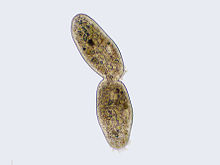- Cleavage furrow
-
In cell biology, the cleavage furrow is the indentation that begins the process of cleavage, by which animal and some algal cells undergo cytokinesis. The same proteins responsible for muscle contraction, actin and myosin begin the process of forming the cleavage furrow. This can only happen in animal cells. Plant cells do not form a cleavage furrow. Instead, plant cells begin cytokinesis with the formation of a cell plate. The cleavage furrow begins on the outside of the cell and moves inward towards the center while the cell plate begins in the center and grows outward to meet the cell wall. Furrow appears because a ring of actin filament forms just inside the plasma membrane, in a plane that bisects the cell. Myosin binds to these actin filaments. Myosin moves the ring of actin filaments on the side of the plasma membrane, and the ring shrinks in size and tightens. The shrinking ring pulls the membrane with it because it is attached to the plasma membrane. The actin and myosin filaments continue to slide past each other, tightening the ring further, until the original membrane is pinched in two and cell division is complete.
Categories:- Cell anatomy
- Cell biology stubs
Wikimedia Foundation. 2010.


